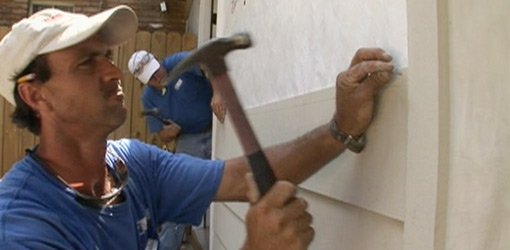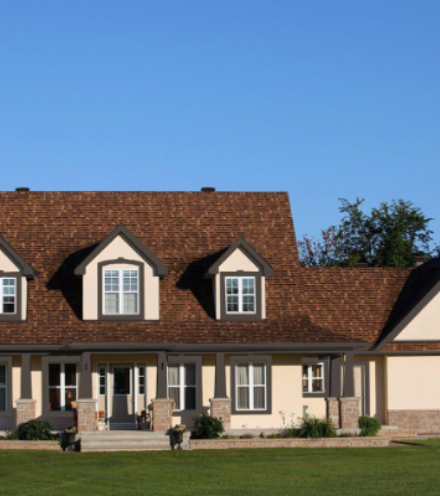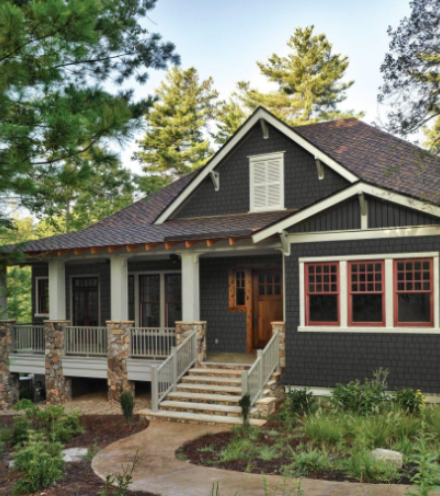As more and more homeowners incorporate green building techniques in combination with style, affordability, and durability one product is rising above its peers in the field – fiber cement siding. Although the product has been around since the 1970s, modern manufacturing methods have increased the availability as well as the style choices available to homeowners. The product has seen massive appeal not only for the homeowners who get to look at it everyday, but also the builders and contractors who are sourcing materials, doing bidding, and actually installing the product.
Fiber Cement Siding Benefits
Here's a look at 20 reasons why fiber cement is so revered across the board.
1. Long Life Span
All of the benefits of fiber cement combine to give it one of the best benefits in the siding industry-longevity. Fiber cement is a composite of cement, wood fiber and other additives which are not only sustainable materials, but ones that withstand the weather, wear, and insects compared to other siding materials. While the upfront costs of fiber cement may be higher compared to vinyl or aluminum, pro-rating those on an annual basis over 50+ years actually makes for a more affordable deal. In fact, a University of Minnesota study recommended fiber cement as the best blend of cost, durability, and environmental impact.

2. Versatility in Style
Fiber cement offers a striking beauty just in the material makeup alone. Compound the natural looks with advanced manufacturing methods and the options for curb appeal aesthetics are bountiful. For example, Allura USA features many colors and textures to choose from. Customers can enjoy a stucco or wood grain look (among others) at a fraction of the price and much less maintenance.

3. The Best Way to Emulate Wood
Try as they might materials like aluminum or vinyl simply cannot emulate the look of wood. Whether it be from their natural gloss or the inability to print realistic grains on their surface faux wood vinyl siding is rarely believable far away, let alone up close. Fiber cement, on the other hand, is perhaps the most realistic option for a wood look without wood staining, repainting, and sealing. The texture of fiber cement has a natural wood feel and the grains can be produced as if they were formed over the years in the forest.

4. Installation Options for Aesthetics
In addition to the various colors and textures of the material itself, there are plenty of options in the actual shape and installation types for fiber cement board. Allura USA features lap siding, shingles, and shakes, or panels that can be installed as is or for the board and batten look. These aesthetics can be mixed and matched within the same project to create a totally unique look from a popular material. Fiber cement soffit and trim also add to the one-of-a-kind look that the product can create.

5. Material is Fire (and Heat) Resistant
Vinyl siding can easily become melted when operating a barbecue grill. Likewise in the unfortunate event of a house fire all (untreated) cedar siding does is become fuel. Fiber cement components, on the other hand, are 1-hour, fire resistance rated and will not ignite under direct flame or heat. Fiber cement has a flame spread rating of 0 and is a Class I material, which for comparison so is brick.

6. Largely Weather Resistant
The fire resistance of fiber cement is great for the safety of your home and family but to get the most out of the investment the product has to last awhile. Because of how it is made, the fiber cement is impact resistant to damage by hail. Extreme heat and humidity can also wreak havoc on some siding types but the makeup of fiber cement makes it dimensionally stable and protected from being damaged in these conditions.

7. Resistant to Warping and Rotting
Fiber cement looks like wood but doesn't act like it. This is a good thing when it comes to absorbing moisture from rain, snow, and heat and humidity. Wood will traditionally swell, warp, and rot which significantly limits its life span but that is not an issue with fiber cement..

8. Ideal for Tornado and Hurricane Prone Areas
The strength and moisture resistance of fiber cement is what makes it a great choice for tornado and hurricane prone areas. Wind-blown objects and excessive gusts can completely destroy vinyl or aluminum siding whereas fiber cement is more durable. This is great not only for homeowners, but contractors who do not need to use valuable time and resources making siding repairs for their customers. Fiber cement siding is very prominent on the Atlantic Coast and the Great Plains among many other regions.

9. Price
For the absolutely lowest priced siding up-front there is no comparison to vinyl. Of course, the looks and style leave much to be desired and do little to increase the curb appeal or market value of the home. According to Homewyse, the cost to install fiber cement siding in the exact middle of the USA (Lebanon, KS) is very competitively priced compared to wood, aluminum and vinyl..

10. Minimal Maintenance Required
One of the great things about fiber cement is that the material is low maintenance. There is no regular pressure washing needed like there is with vinyl and aluminum.

11. Made From Sustainable Materials
Cedar is a sustainable and recyclable material but remember the wood must come from somewhere. Fiber cement, on the other hand, is a mixture of cement, wood fiber and other additives that contain recycled wood. Compared to vinyl siding production fiber cement is much more sustainable, being inert compared to the toxins that are released along every level in the life cycle of vinyl.

12. Approved for Historical Building Renovations
Cities such as Rhinebeck and LaGrange in New York State have approved fiber cement siding for use in their historical district with many other cities following suit. Both homeowners and contractors have more options when it comes to finding suitable finishing materials on projects in these areas.

13. Installation Isn't That Difficult
One of the supposed biggest disadvantages of contractors installing fiber cement siding is how difficult it is to work with. Granted the material doesn't cut as fast as vinyl or aluminum and the long pieces are more brittle than wood but labor costs and resources aren't that increased. Fiber cement installation is generally installed by professionals, but a homeowner with the right tools can complete the job as well.. Gaps do need to be left on edges to account for the expansion and contraction of the fiber cement material (and in wood) but if anything that increases the cutting tolerances.

14. Fiber Cement Cuts a Variety of Ways
Using either a dedicated sheer or a drill attachment cuts the material slower without kicking up anywhere near the amount of dust as a circular saw. Plus, even circular saw dust attachments do a great job of collecting airborne particles without sacrificing cut speed.
OSHA requires installers to use protection with all dust-creating products. either dust masks or dust collecting saws. It is also possible to install dust-free with special shears or snapping tools.

15. Great Warranty
Many household building products boast about their longevity but do little to back up that claim. Shingles are a great example, offering a 15-year warranty but one that is prorated to pennies on the dollar of the original purchase. The Allura warranty provides customers with added protection for many years.. This is a huge advantage for homeowners knowing they'll likely only need to side their house one time and for contractors knowing that a company stands by their materials.

16. Material Has Been Around 100 Years
Some consumers may feel that a 50-year warranty on fiber cement siding is simply calling a bluff. After all, fiber cement siding has only been around since the 1970s and is still 15-20 years away from knowing whether it lasts the full 50 or not. The truth is, fiber cement has been used as siding since the 1970s but the product itself was patented in 1901 under the name “Eternit” roughly translated in Latin to mean everlasting. As modern fiber cement manufacturing processes advance it only makes sense to think that the longevity of the product will extend as well.

17. Also Available in Panels
One of the biggest allures of metal roofing for construction contractors is the fact that 3' X 14' sections of roof can be covered in seconds compared to laying and layering multiple 12” X 36” of individual shingles. Fiber cement siding has the ability to offer that increased coverage as well in the form of architectural panels. The panels come in sizes up to 4' X 10' and are a great way to not only add unique style, but cut down the installation time as well. Even lap siding products are available in widths ranging from 4” to 12” and 12' long.

18. Can Be Painted On-Site (Or in the Factory)
The main theme of fiber cement is options. From the various styles and colors available to widths and more. Another great option is having the fiber cement siding come primed only (paint on site) or in the finished colors. Painting the siding can be a great way for homeowners to save on some material costs. Contracts can also touch up any blemishes that may result in the handling of the materials.
19. Expands and Contracts Less than Wood
Although there will need to be expansion gaps left to account for expansion and contraction in the changing climate, the amount is much less than wood. This helps the contractor who can get away with less than an 1/8” gap instead of recutting the plank. Less expansion and contraction also means that the seam joints will spread apart less, which lessens the possibility of water damage. Since the boards will shrink and expand less, they should be installed closer together at butt seams to avoid gaps.

20. Can Be Blind Nailed If Needed
While most fiber cement boards are blind nailed for aesthetic reasons, they can also be face nailed if needed. The ability to face nail a fiber cement board both on the top as well as the bottom or middle makes it more secure in high wind climates. The nails on the face can easily be covered with touch up paint and are difficult to distinguish anywhere other than up close. Comparatively, vinyl or aluminum siding can only be fastened at the top nailing lip.

Fiber cement siding definitely has its advantages which will push for the material to become much more mainstream sooner rather than later.




